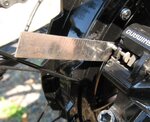Larry,
you might consider getting a set of whatever brake you consider and sending a caliper to a couple people for evaluation. For example, the AVID BB7 has a great reputation and looks to be hand adjustable on both sides of the pad so I bought a set. I will install them, although with my custom tool adjusting the M375 is easy. The problem with the AVID BB7 caliper is that the inner adjusting wheel is so stiff they put a Torx drive recess in the center of it and most people use a Torx drive screwdriver. Of course the hub motor eliminates that possibility and makes it even harder to adjust by hand, so you are right back to having to drop the wheel. My solution was to dismantle the caliper, reassemble just the click-wheel assembly, and use a Torx drive bit in a cordless drill to spin the two parts against each other to wear down the ratchet nubs. Now it's stiff but manageable. So, I would love to see the Promax to see if it solves the problem without adding a new problem.


